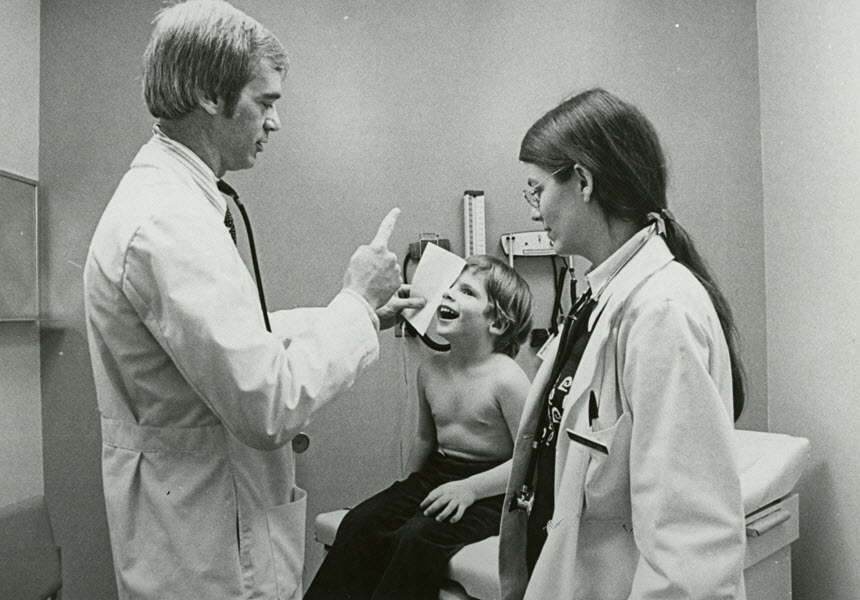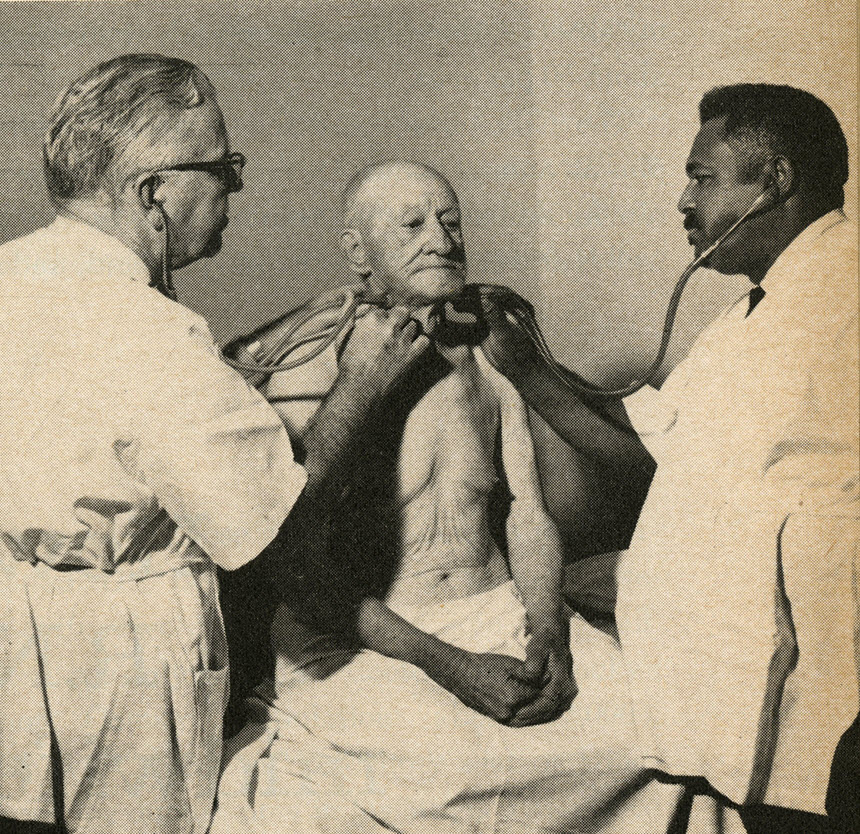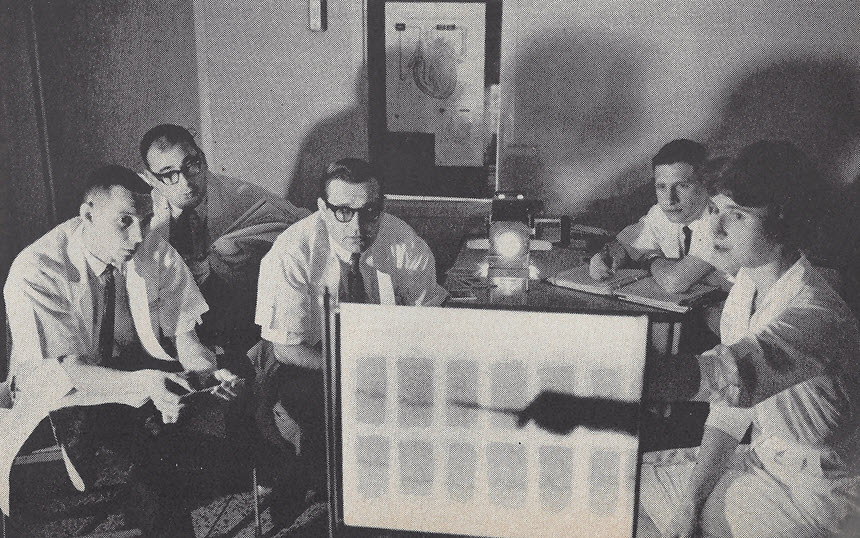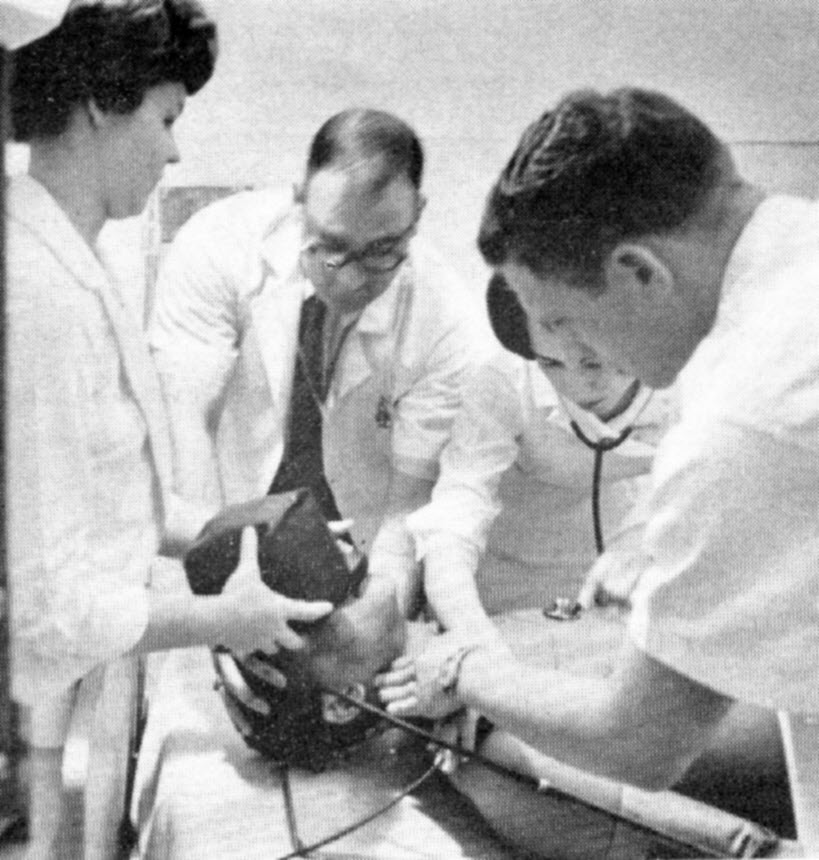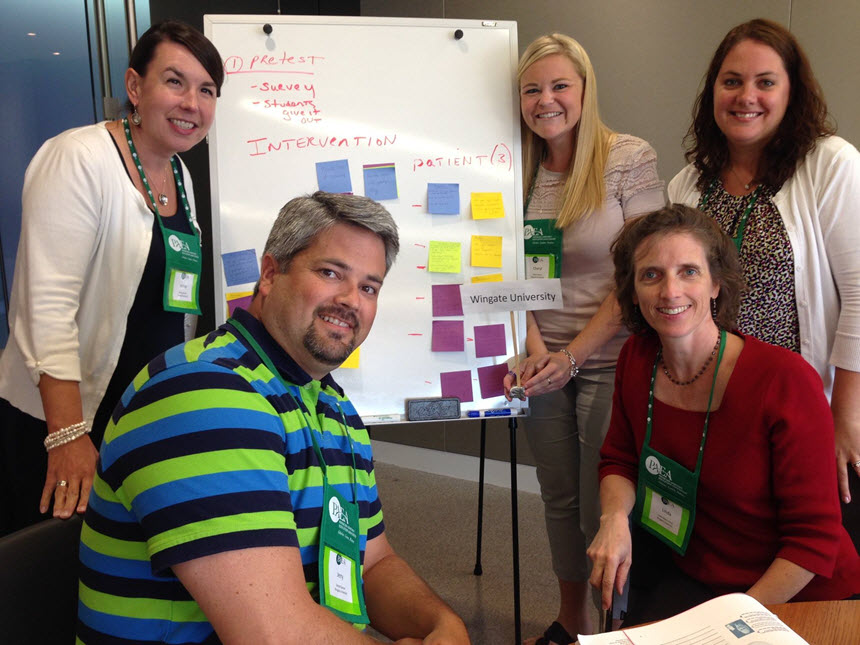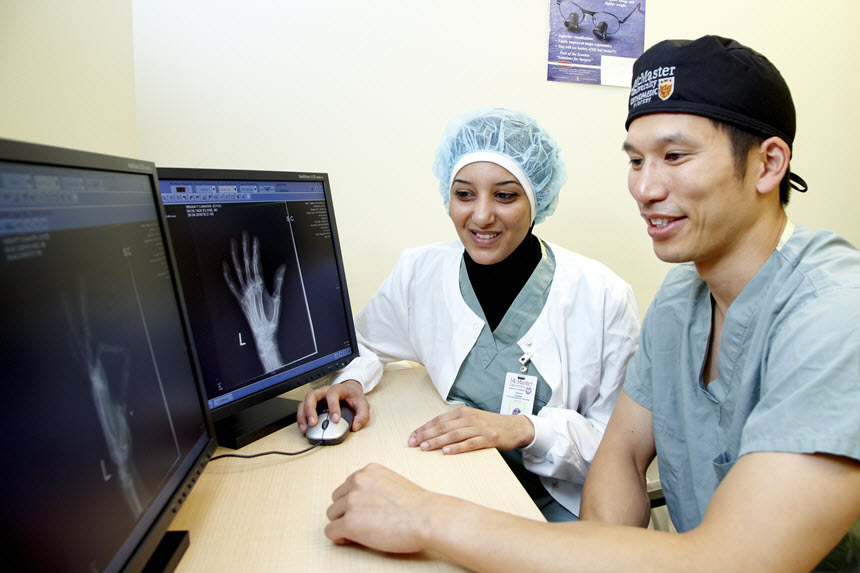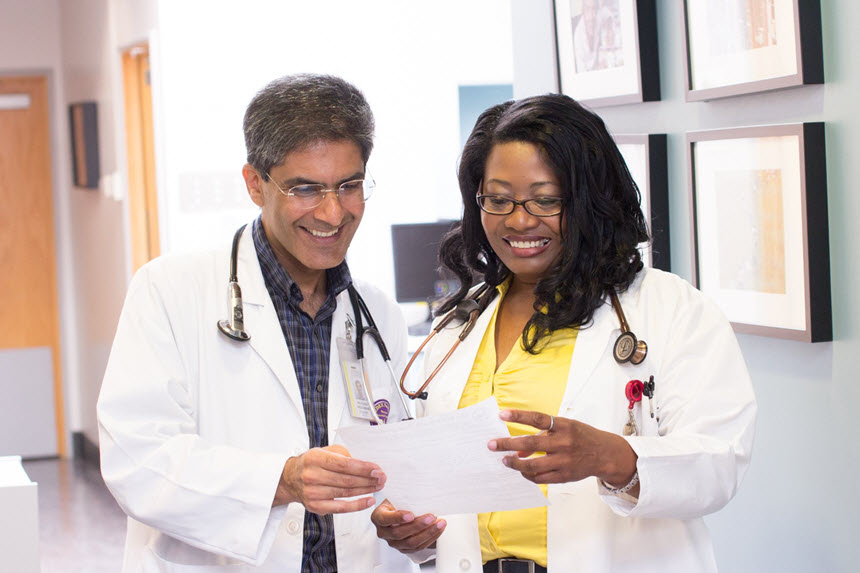PAs are educated and trained to collaborate with other health professionals. During their coursework and clinical training, PAs learn from and work with physicians, other PAs, nurses, and additional health care professionals in a variety of settings.
American physician Eugene Stead created the profession’s partner-based foundation. He modeled it after the collaborative relationship between Dr. Amos Johnson and his assistant, Buddy Treadwell, who had worked together in rural North Carolina since the 1940s. Dr. Stead opened the first academic PA program at Duke University in 1965, which educated students to care for patients with physician oversight. The program provided two years of broad medical training in anatomy, physiology, laboratory science, medicine, and surgery.
A PA student (right) from George Washington University observes a doctor performing an eye exam during a rotation, Washington, DC, ca. 1970s
Courtesy National Library of Medicine
Dr. Amos Johnson (left) teaches assistant, Buddy Treadwell (right), to identify patient Douglas Carter’s carotid artery, Garland, NC, 1967
Courtesy National Library of Medicine
Beginning in the 1940s, Johnson trained Treadwell to assist his general practice in rural North Carolina. Treadwell learned to conduct initial patient examinations, oversee treatments, and perform emergency procedures. Over time, the community accepted him as a trusted health care provider, in addition to Johnson.
Nurse Kaye Andreoli (right) teaches the first PA students at Duke University, (right to left) Don Guffey, Victor Germino, Richard Scheele, and Kenneth Ferrell, to interpret an electrocardiograph (EKG) recording, Durham, NC, 1966
Courtesy Physician Assistant History Society
The four students in the inaugural class of Duke’s PA studies program were all former U.S. Navy Hospital Corpsmen. Their time as corpsmen provided them with practical medical experience in the field, making them good candidates for the program.
Duke University students Victor Germino (center) and Kenneth Ferrell (right) practice intubation skills on a mannequin, under nurse supervision—Germino feeds the “patient” oxygen, while Ferrell checks its condition, Durham, NC, 1966
Courtesy Physician Assistant History Society
During a collaborative training exercise, students from Indiana State University’s PA studies, nursing, and athletic training programs work together with the local fire department and paramedics to care for a “football coach” who suffered a heart attack on the sidelines of a game, Terre Haute, IN, 2013
Courtesy Indiana State University
Through interprofessional training, drills, and cooperation, schools like Indiana State hope to eliminate the divisions that occur among health care professionals in different fields and promote mutual respect.
A team of PA studies, pharmacy, and nursing students from Wingate University present the ideas behind their award-winning project at the annual Physician Assistant Education Academy conference in Washington, DC, 2015
Courtesy Wingate University
As part of the PA Education Association’s Interprofessional Leadership Program to promote collaboration, Wingate’s interdisciplinary team designed a project to improve oral health care in western North Carolina.
Canadian PA, Ohood Elzibak, CCPA (left) works with Dr. Ivan Wong, a specialized orthopedic surgeon, at Hamilton General Hospital, Hamilton, Canada, 2010
Courtesy McMaster University
During a student rotation, Elzibak trained under Dr. Wong for two months. After she graduated, Wong hired Elzibak as the first PA on his surgical team, making him one of the earliest Ontario physicians to employ a PA. Their partnership allowed Wong to see new patients and spend more time with each person.
Norma Nunez, PA-C (right) supervises Merdad Meraban during a student rotation in primary care at Neighborcare Health Rainier Park Medical Clinic, Seattle, WA, 2013
Courtesy MEDEX Northwest, University of Washington
Originally from Honduras, Nunez shared the experience of immigration with her student. Before immigrating to the United States in 2003, Meraban was an established doctor in Iran. He chose to enroll in a PA studies program, because it provided the fastest and most effective way to return to practicing medicine.
A PA student (right) from George Washington University observes a doctor performing an eye exam during a rotation, Washington, DC, ca. 1970s
Courtesy National Library of Medicine
Dr. Amos Johnson (left) teaches assistant, Buddy Treadwell (right), to identify patient Douglas Carter’s carotid artery, Garland, NC, 1967
Courtesy National Library of Medicine
Beginning in the 1940s, Johnson trained Treadwell to assist his general practice in rural North Carolina. Treadwell learned to conduct initial patient examinations, oversee treatments, and perform emergency procedures. Over time, the community accepted him as a trusted health care provider, in addition to Johnson.
Nurse Kaye Andreoli (right) teaches the first PA students at Duke University, (right to left) Don Guffey, Victor Germino, Richard Scheele, and Kenneth Ferrell, to interpret an electrocardiograph (EKG) recording, Durham, NC, 1966
Courtesy Physician Assistant History Society
The four students in the inaugural class of Duke’s PA studies program were all former U.S. Navy Hospital Corpsmen. Their time as corpsmen provided them with practical medical experience in the field, making them good candidates for the program.
Duke University students Victor Germino (center) and Kenneth Ferrell (right) practice intubation skills on a mannequin, under nurse supervision—Germino feeds the “patient” oxygen, while Ferrell checks its condition, Durham, NC, 1966
Courtesy Physician Assistant History Society
During a collaborative training exercise, students from Indiana State University’s PA studies, nursing, and athletic training programs work together with the local fire department and paramedics to care for a “football coach” who suffered a heart attack on the sidelines of a game, Terre Haute, IN, 2013
Courtesy Indiana State University
Through interprofessional training, drills, and cooperation, schools like Indiana State hope to eliminate the divisions that occur among health care professionals in different fields and promote mutual respect.
A team of PA studies, pharmacy, and nursing students from Wingate University present the ideas behind their award-winning project at the annual Physician Assistant Education Academy conference in Washington, DC, 2015
Courtesy Wingate University
As part of the PA Education Association’s Interprofessional Leadership Program to promote collaboration, Wingate’s interdisciplinary team designed a project to improve oral health care in western North Carolina.
Canadian PA, Ohood Elzibak, CCPA (left) works with Dr. Ivan Wong, a specialized orthopedic surgeon, at Hamilton General Hospital, Hamilton, Canada, 2010
Courtesy McMaster University
During a student rotation, Elzibak trained under Dr. Wong for two months. After she graduated, Wong hired Elzibak as the first PA on his surgical team, making him one of the earliest Ontario physicians to employ a PA. Their partnership allowed Wong to see new patients and spend more time with each person.
Norma Nunez, PA-C (right) supervises Merdad Meraban during a student rotation in primary care at Neighborcare Health Rainier Park Medical Clinic, Seattle, WA, 2013
Courtesy MEDEX Northwest, University of Washington
Originally from Honduras, Nunez shared the experience of immigration with her student. Before immigrating to the United States in 2003, Meraban was an established doctor in Iran. He chose to enroll in a PA studies program, because it provided the fastest and most effective way to return to practicing medicine.
PAs are educated and trained to collaborate with other health professionals. During their coursework and clinical training, PAs learn from and work with physicians, other PAs, nurses, and additional health care professionals in a variety of settings.
American physician Eugene Stead created the profession’s partner-based foundation. He modeled it after the collaborative relationship between Dr. Amos Johnson and his assistant, Buddy Treadwell, who had worked together in rural North Carolina since the 1940s. Dr. Stead opened the first academic PA program at Duke University in 1965, which educated students to care for patients with physician oversight. The program provided two years of broad medical training in anatomy, physiology, laboratory science, medicine, and surgery.










